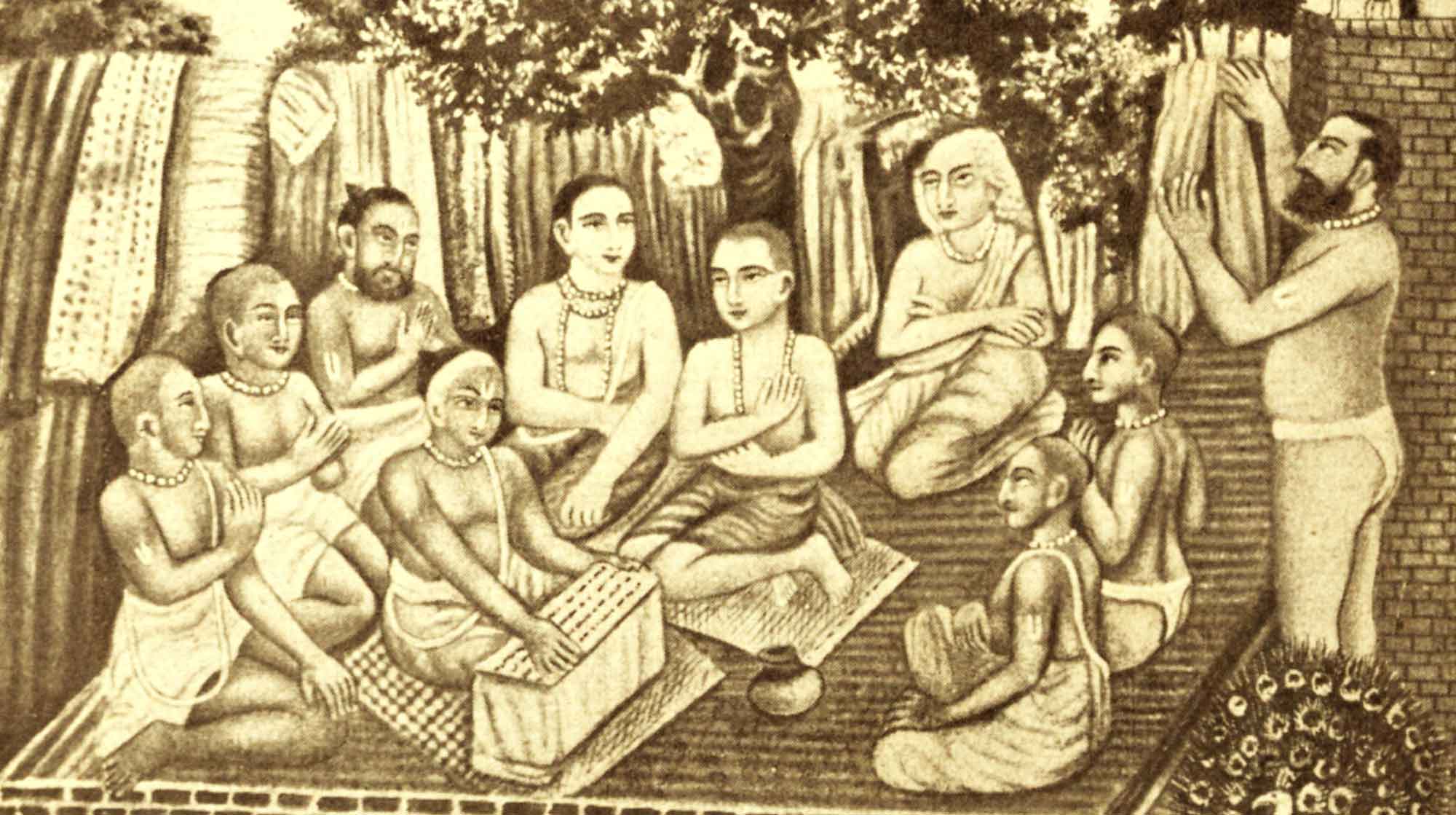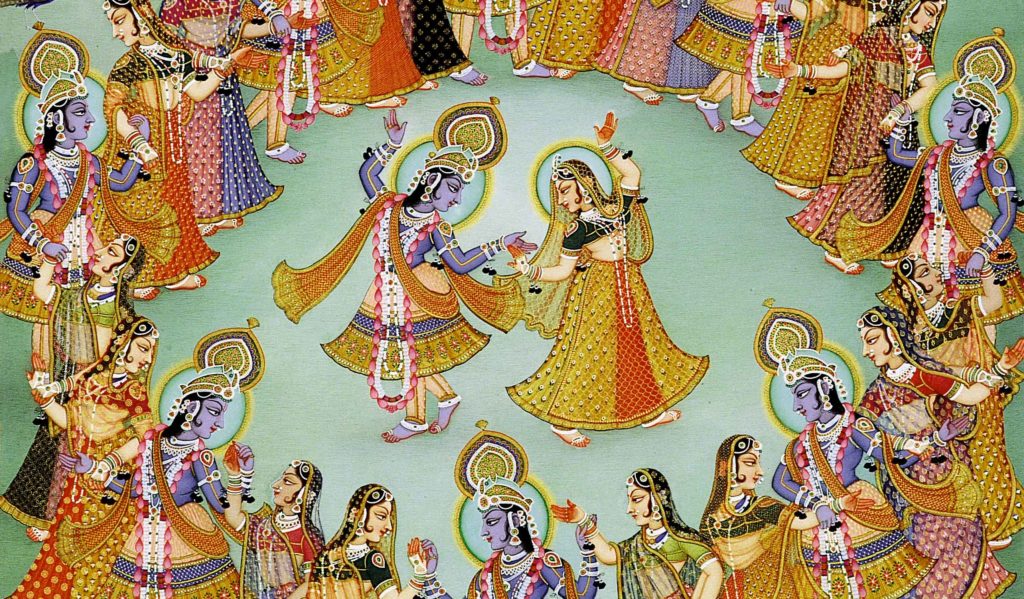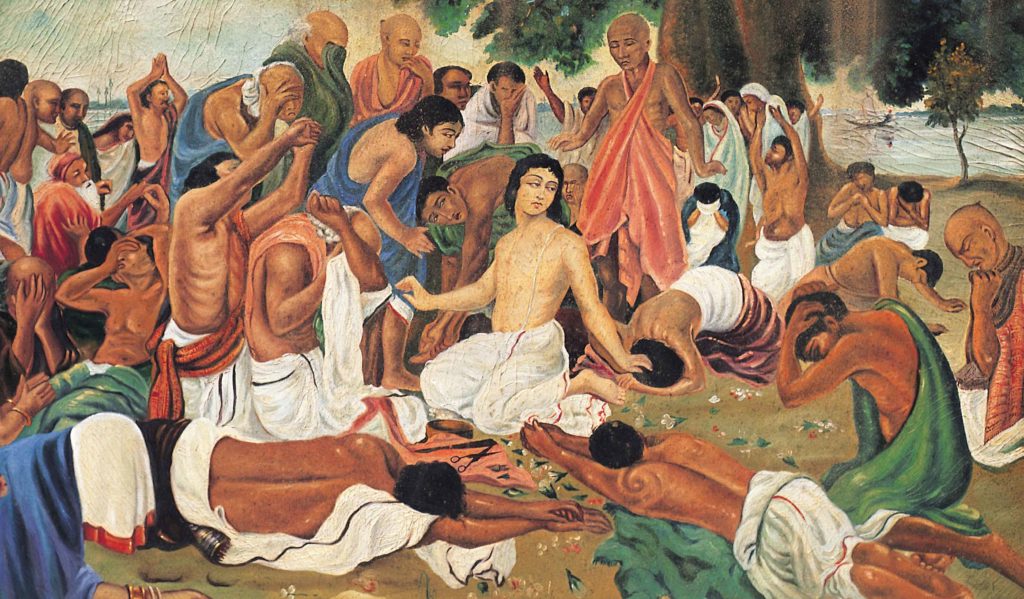Overview
"Harmony - Real and Apparent" written by Swami B.V. Giri, explains the true meaning of harmony as opposed to the 'pseudo-harmony' which is sometimes spoken about in the greater Vaiṣṇava world of today.
Take a precursory look at the news and it is obvious that we live in a world of discord. War, religious strife, terrorism, racism, social upheaval and discrimination are everyday events and have been since time immemorial. Whenever any of the above scenarios rear their ugly heads, it is not long before a chorus of voices cries out for peace and harmony.
Even in the Vaiṣnava world today we hear calls for harmony. Due to various reasons, the devotee community is divided into many, many missions – some small, some large, some popular, some not so well known, some with one ācārya, some with many. Amongst these various groups there are some devotees who desire to bring all these institutions together under one umbrella in order to work harmoniously to spread Kṛṣṇa consciousness. At first glance such an idea seems very noble and laudable – but what is their concept of harmony?
WHAT IS HARMONY?
Etymologically, the English word ‘harmony’ is derived from the Greek word harmonia, meaning ‘to join’. Similarly, in Sanskrit the word for harmony, samanvaya, also means ‘to join’. Samanvaya can be broken down into two words – sam +anvaya. Sam means ‘to join together’ and anvayaḥ means ‘to put things in an order.’ Another Sanskrit word that is frequently used to denote harmony is samarasa, Samarasa literally means, ‘to have the same taste’. Although samanvaya and samarasa may seem to be the same, they are not. Samanvaya means to join together in order to methodically engage in a common pursuit. Samarasa implies something of a non-discriminatory nature and carries with it the connotation of accepting all points of view without discrimination.
Harmony/samanvaya does not infer that one must abandon all discrimination. Yet some advocates of harmonious Vaiṣnava dealings are prepared to throw discrimination to the four winds and ignore all philosophical divergences, only emphasizing the external aspects of Kṛṣṇa consciousness that are common to all. That is not samanvaya – that is samarasa.
Real harmony does not lie in homogenising everything based upon the common traits shared by all denominations of Vaiṣnavas. Real harmony does not mean picnicking together or having a few bhajanas in the name of inter-Vaiṣnava relations. To engage solely in these activities is not real harmony. Real harmony lies in cultivating the correct understanding of Vaiṣnava siddhānta. This was the reason why Śrī Jīva Gosvāmī originally established the Viśva Vaiṣnava Rājya Sabhā at the Rādhā-Dāmodara temple in Vṛndāvana.
Śrī Jīva attracted the most advanced souls of that time through the teachings of Śrīla Rupa Gosvāmī Prabhupāda. Rādhā-Dāmodara Temple was not a playground for misconceptions and superficial pleasantries amongst divided dysfunctional groups of devotees. The Viśva Vaiṣnava Rājya Sabhā was an assembly of exemplary devotees who taught according to the Ṣaṭ-Sandarbhas of Śrī Jīva and the bhakti-śāstras of Śrī Rūpa and Śrī Sanātana.
In 1936, on the disappearance day of Ṭhākura Bhaktivinoda, Śrīla Bhaktisiddhānta Sarasvatī Gosvāmī Prabhupāda explained that the purpose of the Viśva Vaiṣnava Rājya Sabhā was to spread the message of the bhaktivinoda-dhārā (the philosophical line of Bhaktivinoda):
“The only way is through the bhaktivinoda–dhārā. The bhaktivinoda– dhārā must be kept alive by the kīrtana of srauta–vani (the instructions of the scriptures and ācāryas). If kirtana of the truth is stopped, then we will be severed from the bhaktivinoda–dhārā.”
When Sarasvatī Ṭhākura reestablished the Viśva Vaiṣnava Rājya Sabhā in 1919, he did not extend an open invitation to all groups of Vaiṣnavas. The Sabhā did not include Vaiṣnavas of different sampradāyas, nor did it include those who were opposed to the teachings of Śrī Caitanya, māyāvādīs, sahajiyās and other such aparādhīs. The Sabhā only consisted of his own disciples and followers. This was because the various Vaiṣnava societies at that time were permeated with apa-siddhānta and did not represent the pure ideals of Bhaktivinoda and the Viśva Vaiṣnava Rājya Sabhā.
However, today the situation is very different and much more complex. Many philosophical misconceptions have become deep-rooted and widespread within some of the branches of our very own paramparā. Therefore the need of the hour is not to see how many Vaiṣnava groups we can get together under one roof – the real necessity is to try to propagate the concepts of Bhaktivinoda and Sarasvatī Ṭhākura within our very own line.
Such words may not be palatable to hear, but we are not advocates of satyaṁ brūyāt priyaṁ brūyāt (speak the truth, but only speak it when it is palatable). This maxim is for those that are worldly, not for those that speak the absolute truth.
“According to social conventions, if you want to speak truth, you must limit yourself to truths that are palatable and flattering. Don’t speak unpalatable truths. But we are not meant to merely follow social conventions. We are preachers and servants of God.” (A.C. Bhaktivedānta Svāmī Prabhupāda, Bombay, January 3rd 1977)
Rather, we should speak plainly. As Cāṇakya Paṇḍita says, spaṣṭa-vaktā na vañchakaḥ (‘one who speaks plainly is not a deceiver’). Śrīla Sarasvatī Ṭhākura has clearly explained that a loyal servant of the truth must speak plainly, even if his words create controversy:
“The truth (satya) is propagated in a twofold way – positively or by the method of direct support and negatively by the method of opposition. The truth cannot be made sufficiently known by the positive method alone. The positive method by itself is not the most effective mode of propaganda in a controversial age like the present. The negative method which seeks to differentiate the truth from non-truth in all its forms, is even better calculated to convey the directly inconceivable significance of the Absolute. It is a necessity which cannot be conscientiously avoided by the dedicated preacher of the truth if he wants to be a loyal servant of Godhead. The method is sure to create an atmosphere of controversy in which it is quite easy to lose one’s balance of judgment. But the ways of the deluding energy are so intricate that unless their mischievous nature is fully exposed it is not possible for the soul in the conditioned state to avoid the snares spread by the enchantress for encompassing the ruin of her only too willing victims. It is a duty which shall be sacred to all who have been enabled to obtain even a distant glimpse of the Absolute.” (The Harmonist, Vol. 29)
THE NECESSITY FOR DIVERSITY
Some years ago, our Guru Mahārāja, Śrīla Bhakti Gaurava Narasiṅgha Mahārāja, was asked the question, “How can we unite all the Vaiṣnavas?” His reply was thus:
“I am not for the Unitarian Kṛṣṇa Conscious Church – I am for the church of variagatedness and difference. Based on that, I choose my association. I think that variagatedness breeds a very strong and healthy spiritual environment. We are not followers of the ‘Rodney King philosophy’ – there was a man in America called Rodney King who was beaten up and then there was a riot in Los Angeles. So he went on TV and said, “Can’t we all just get along?” Well the answer is, “No Rodney, we can’t!” We can’t because there are differences. Everyone is not the same; therefore we can’t all live the same. Why isn’t everyone wearing sannyāsa-veśa? Because everyone can’t do it. Or why is it that everyone isn’t a brahmacārī? Why doesn’t everybody become a householder? Because it is not ‘one thing for everybody’. There doesn’t have to be hatred in diversity. There should be harmony and appreciation – but there is diversity and we can’t erase that. There’s life in diversity. “(Hungary, August 2nd 2006)
Diversity is at the very heart of Gauḍīya Vaiṣnavism and that diversity is called rasa. Within the spiritual realm there is unity and diversity – all the denizens there are united in pleasing the transcendental senses of Govinda, but in order to fulfil that, diversity is a prerequisite. There are diverse rasas and within each rasa there are divisions, sub-divisions and sub-sub-divisions. By nature, each division is diverse, but all divisions share the common goal of serving Śrī Śrī Rādhā-Kṛṣṇa. In this regard Śrīla Śrīdhara Mahārāja says:
“Yaśoda is always afraid of Devakī and Vasudeva: “What? They’ll come and claim our child as their own? How can that be?” And Rādhārāṇī’s camp thinks that Candrāvalī’s group are anti-parties. So in all rasas there is harmony in discord. It is the necessity of the nature of līlā. Bifurcation. Thesis, antithesis and synthesis. Synthesis means there are many antitheses. Harmony means many. Plurality must be there. In the Upaniṣads it is said that, neha nānāsti kiñcana – “There is no plurality.” But this means no nānā – not many, in the sense that all are harmonized into one common interest. ‘Not many’ means not many different independent interests, but rather that are all meeting for a common cause.”
FIGHTING IS LIFE!
In order to achieve real harmony, fighting against misconception is necessary. Yet some devotees will shun any type of philosophical discussion in the name of retaining harmony. The kanistha-adhikari will shun any type of controversy, thinking that such talks will create obstacles to their spiritual advancement. This mentality goes against the advice of Śrīla Kavirāja Gosvāmī:
siddhānta baliyā citte nā kara alasa
ihā ha-ite kṛṣṇe lāge sudṛḍha mānasa
“Do not be lazy in your mind when it comes to discussing siddhānta. Through such discussions, your mind becomes firmly fixed upon Kṛṣṇa.” (Cc. Ādi-līlā 2.117)
Śrīla Śrīdhara Mahārāja was once approached by a despondent devotee who lamented that he could not understand why there were so many differences between different Vaiṣnava groups. Why couldn’t ‘they all just get along?’ Śrīla Śrīdhara Mahārāja responded:
“So many things are to be understood. Kṛṣṇa is the cause of Kurukṣetra fighting, do you know that? In His presence the whole Yadu-vaṁśa was finished and He was a sightseer. What is that? Can you understand this? How can you adjust? What is the difference between Kṛṣṇa and Balarāma? Why does Balarāma side with Duryodhana and Kṛṣṇa sides with the Pāṇḍavas? Why? They are almost one and the same! What is your answer? All is bogus?
Fighting is life! Fighting is life! I must turn and preach this. Until and unless I can change my understanding, Physical oneness is not one. To maintain physical peace is lack of vitality. We must be true to our own understanding. You want to crush everything – jumble everything together into one mass. But that is all stone, fossilized. Do you want to see a fossilized unity? What is the conception of harmony? Harmony means independent thinking.
There are different rasas – Kṛṣṇa is not representing only one feature. He is of infinite features to accommodate infinite possibilities. That is Akhila-rasāmṛta-murti – there are different groups and in the same group there are so many different arrangements. Rādhārāṇī and Candrāvalīi are fighting – two camps fighting to satisfy Him. We have to understand how it is possible. With humility we have to try to follow how it is possible. The opposition party is there in the parliament to enhance the work of the main party. In this way direct and indirect makes everything complete. And if that is distributed everywhere, then there will be no difficulty to understand the differences there.
Śaṅkara and Buddha preferred that the ultimate goal is undifferentiated, unknown and unknowable. All harmonised into death. That is brahma-nirvana or prākṛti-nirvāṇa. Their brain went so far, but the final piece – no differentiation, no trouble – all bathed in eternal slumber. If you prefer, you can follow that school. (Navadvīpa, 28th May 1983)
We are not opposed to harmony, but harmony must be understood in the right context and not as an external show of saccharine smiles, hugs and honeyed words. Let the Vaiṣnavas be diverse in their approaches to preaching and let them be united in siddhānta. If devotees truly desire real unity and harmony, this can only be achieved through following bhaktisiddhānta-vāṇī.
“Variety meets unity in different planes of movement. That is harmony. This applies everywhere, including the plane of colour and the plane of sound. Many branches meet together in the trunk of a tree, the trunk harmonises the many leaves, this is the movement of Caitanya Mahāprabhu. We must see a common master, and work around the will of that master or conductor.” (Śrīla Śrīdhara Mahārāja)
As members of the sārasvata-paramparā, the ‘common master’ that we all share is Śrīla Bhaktisiddhānta Sarasvatī Prabhupāda and it is our duty to follow his will and his precepts attentively. Any other process we concoct to unify the fragmented Vaiṣnava world will simply be temporary, superficial and futile. If we neglect or adulterate bhaktisiddhānta-vāṇī in the name of harmony, we will “stop the kīrtana of truth.” Then, in the words of Sarasvatī Ṭhākura, “We will be severed from the line of Bhaktivinoda.”
Related Articles & Books
- Vaiṣṇava Nindā by Śrīla Bhaktivinoda Ṭhākura
- A Devotee is Merciful (Sajjana – Kṛpālu) by Śrīla Bhaktisiddhānta Sarasvatī Ṭhākura
- A Devotee Does Not Engage in Violence (Sajjana – Akṛta-droha) by Śrīla Bhaktisiddhānta Sarasvatī Ṭhākura
- A Devotee is the Epitome of Truth (Sajjana – Satya-sāra) by Śrīla Bhaktisiddhānta Sarasvatī Thākura
- Śiva-tattva & the Position of Lord Śiva by Śrīla B.R. Śrīdhara Mahārāja
- Oh Bābā! Bolacche-re! by Śrīla B.R. Śrīdhara Mahārāja
- Problems and Solutions by Śrīla B.R. Śrīdhara Mahārāja
- The Highest Attainment and Present Adjustment by Śrīla B.R. Śrīdhara Mahārāja
- Āgun Jvālbe (Light the Fire!) by Śrīla B.R. Śrīdhara Mahārāja
- Dharma and the Modern World by Śrīla A.C. Bhaktivedānta Swami Prabhupāda
- Faith Confirms the Absolute by Śrīla B.G. Narasiṅgha Mahārāja
- Go Deeper! by Śrīla B.G. Narasiṅgha Mahārāja
- To Be a Servant by Śrīla B.G. Narasiṅgha Mahārāja
- Harmony – Real and Apparent by Swami B.V. Giri
- The Definition of Faith by Gaura Gopāla Dāsa
- Ātma Samīkṣā – The Value of Introspection by Kalki Dāsa
- Frogs in the Well of Prejudice by Kalki Dāsa
Further Reading
- Śraddhā (Faith) – Quotes by Bhaktivinoda Thakura
- Śraddhā and Śaraṇāgati by Śrīla Bhaktivinoda Ṭhākura
- The Association of Sādhus by Śrīla Bhaktivinoda Ṭhākura
- Epilogue to Śrī Kṛṣṇa Karṇāmṛta by Śrīla Bhaktivinoda Ṭhākura
- Prīti (Love) by Śrīla Bhaktivinoda Ṭhākura
- A Dispute Concerning Mahāprasāda by Śrīla Bhaktivinoda Ṭhākura
- Śraddhā by Śrīla Bhaktivinoda Ṭhākura
- Materialistic Association by Śrīla Bhaktivinoda Ṭhākura
- Dispelling Doubts by Śrīla Bhaktivinoda Ṭhākura
- The Enemy by Śrīla Bhaktivinoda Ṭhākura
- A Critique of the book ‘Vanamālā’ by Śrīla Bhaktivinoda Ṭhākura
- Kali by Śrīla Bhaktivinoda Ṭhākura
- Offences Against Bhakti by Śrīla Bhaktivinoda Ṭhākura
- Kārttika-vrata by Śrīla Bhaktivinoda Ṭhākura
- Violence and Mercy by Śrīla Bhaktivinoda Ṭhākura
- Abandoning Bad Association by Śrīla Bhaktivinoda Ṭhākura
- Sad-guṇa and Bhakti by Śrīla Bhaktivinoda Ṭhākura
- The Process of Initiation by Śrīla Bhaktivinoda Ṭhākura
- Dainya (Humility) by Śrīla Bhaktivinoda Ṭhākura
- Vaiṣṇava Nindā (Offences to Devotees) by Śrīla Bhaktivinoda Ṭhākura
Prema Dhāma Deva Stotram with the Narasiṅgha Sevaka Commentary – Verses 61-65
In verses 61 to 65 of 'Prema Dhāma Deva Stotram', Śrīla Śrīdhara Mahārāja narrates the pastime of Śrī Caitanya at Caṭaka Parvata In Purī and explains how the scriptures produced by Brahmā and Śiva are ultimately searching for the personality of Mahāprabhu who is merciful too all jīvas, no matter what their social position.
Prabhupāda Śrīla Sarasvatī Ṭhākura’s Visit to Ayodhyā
With the forthcoming observance of Śrī Rāma Navamī, we present 'Prabhupāda Śrīla Sarasvatī Ṭhākura’s Visit to Ayodhyā' written by Śrīla Bhaktisiddhānta Sarasvatī Ṭhākura Prabhupāda from The Gaudīyā magazine, Vol 3. Issue 21/ In December 1924, after visiting Benares and Prāyāga, Sarasvatī Ṭhākura visited the birth-site of Śrī Rāmācandra in Ayodhyā.
Śaraṇāgati – The Only Path to Auspiciousness
In this article, 'Śaraṇāgati - The Only Path to Auspiciousness', Dhīra Lalitā Dāsī analyses the process of śaraṇāgati (surrender) beginning with śraddhā (faith). She also discusses the role of śāstra and the Vaiṣṇava in connection with surrender.
Ātma Samīkṣā – The Value of Introspection
In this article, "Ātma Samīkṣā – The Value of Introspection" Kalki Dāsa highlights the importance of introspection in the life of a devotee and especially in relation to the worldly environment that surrounds us. He also explains how transcendental sound influences our capacity to introspect.
Prema Dhāma Deva Stotram with the Narasiṅgha Sevaka Commentary – Verses 61-65
In verses 61 to 65 of 'Prema Dhāma Deva Stotram', Śrīla Śrīdhara Mahārāja narrates the pastime of Śrī Caitanya at Caṭaka Parvata In Purī and explains how the scriptures produced by Brahmā and Śiva are ultimately searching for the personality of Mahāprabhu who is merciful too all jīvas, no matter what their social position.
Prabhupāda Śrīla Sarasvatī Ṭhākura’s Visit to Ayodhyā
With the forthcoming observance of Śrī Rāma Navamī, we present 'Prabhupāda Śrīla Sarasvatī Ṭhākura’s Visit to Ayodhyā' written by Śrīla Bhaktisiddhānta Sarasvatī Ṭhākura Prabhupāda from The Gaudīyā magazine, Vol 3. Issue 21/ In December 1924, after visiting Benares and Prāyāga, Sarasvatī Ṭhākura visited the birth-site of Śrī Rāmācandra in Ayodhyā.
Śaraṇāgati – The Only Path to Auspiciousness
In this article, 'Śaraṇāgati - The Only Path to Auspiciousness', Dhīra Lalitā Dāsī analyses the process of śaraṇāgati (surrender) beginning with śraddhā (faith). She also discusses the role of śāstra and the Vaiṣṇava in connection with surrender.
Ātma Samīkṣā – The Value of Introspection
In this article, "Ātma Samīkṣā – The Value of Introspection" Kalki Dāsa highlights the importance of introspection in the life of a devotee and especially in relation to the worldly environment that surrounds us. He also explains how transcendental sound influences our capacity to introspect.








